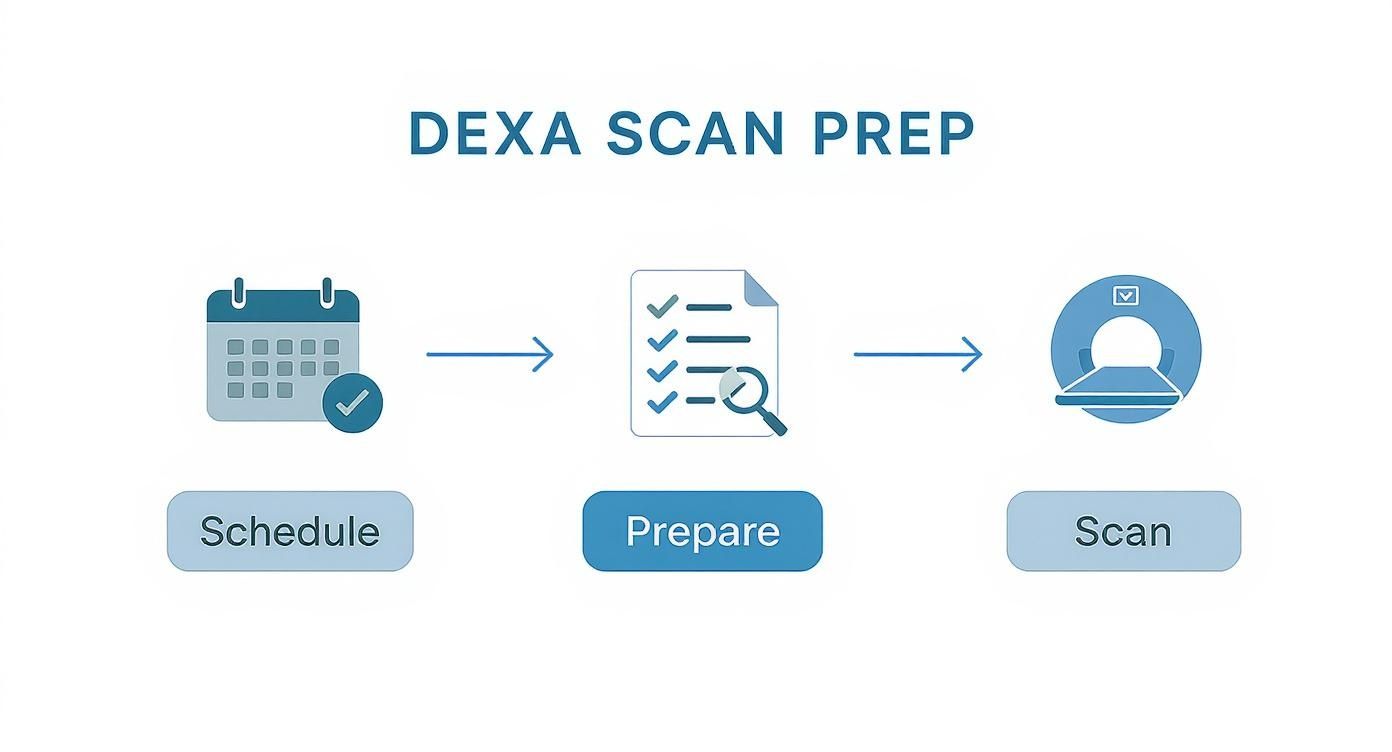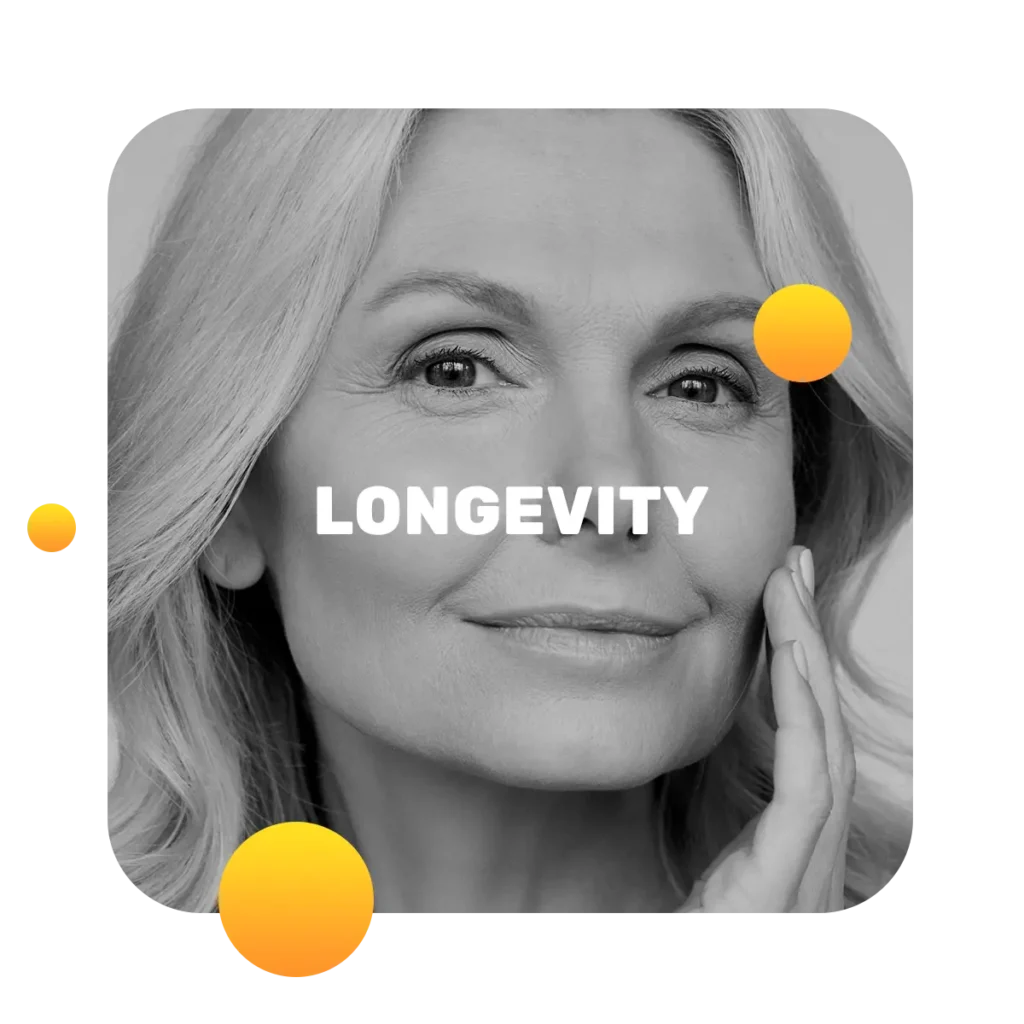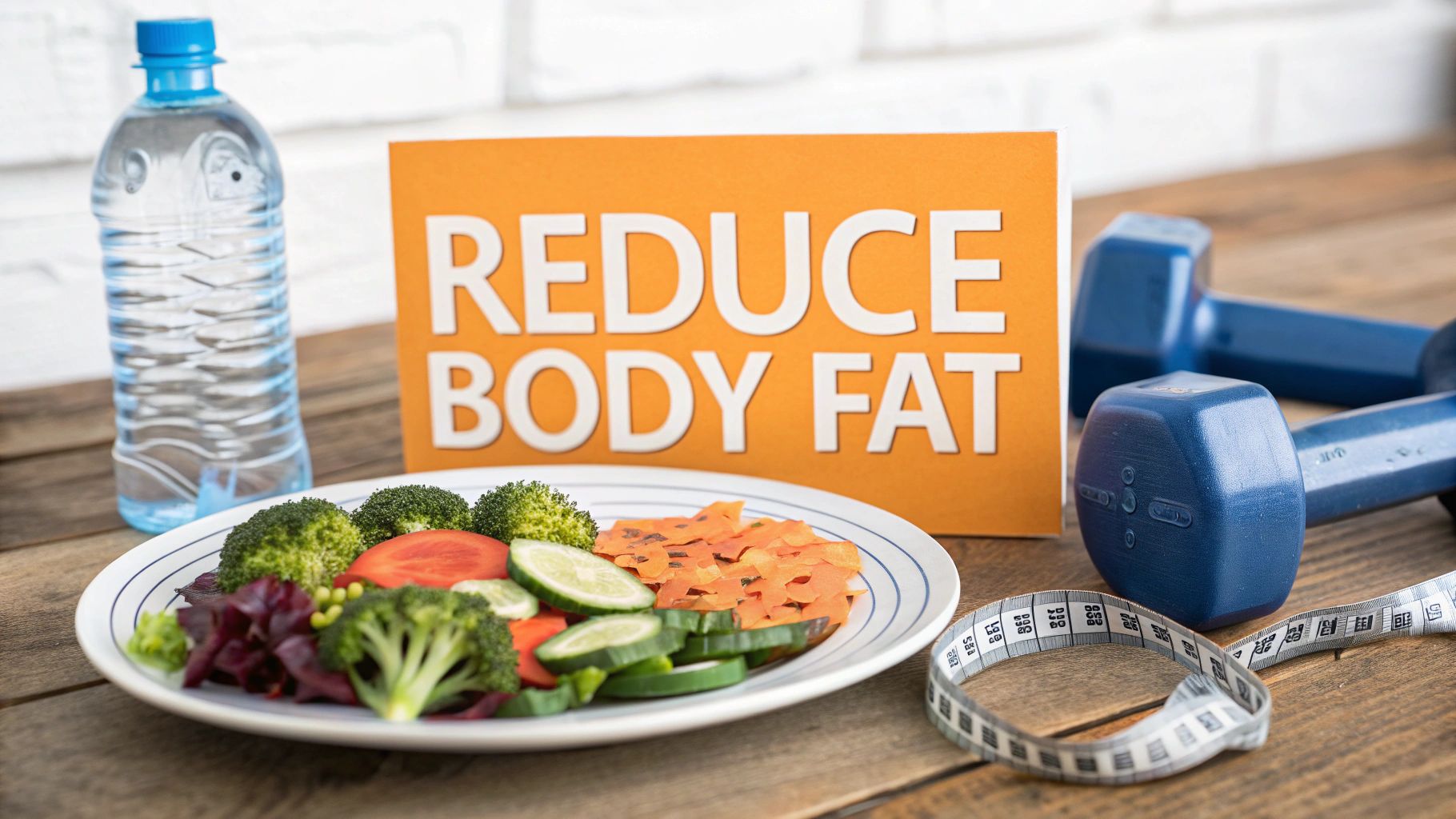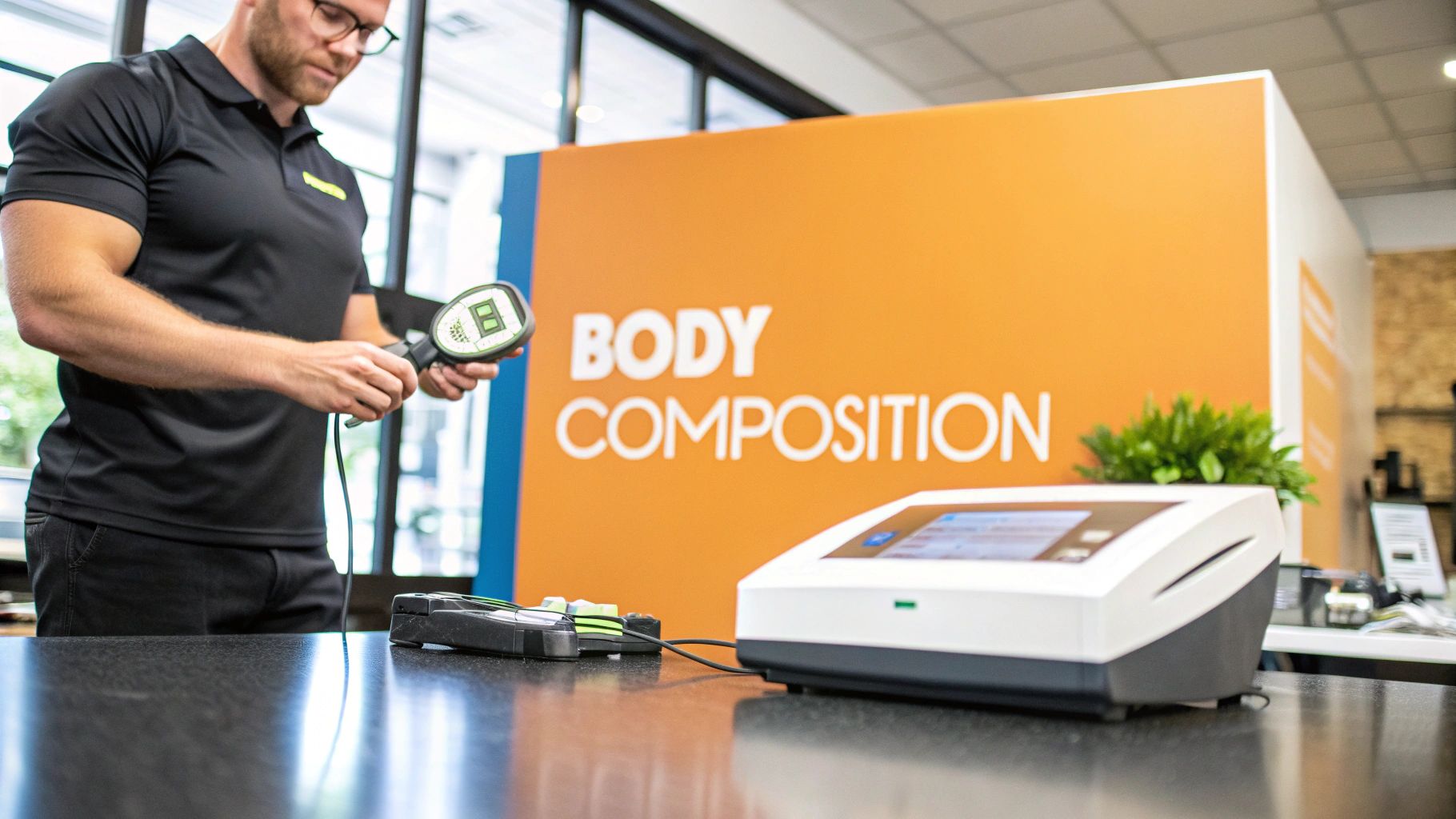For decades, the bathroom scale has been the only tool most of us used to track our health. But that number on the scale? It tells a painfully incomplete story.
Your total weight doesn't know the difference between a pound of fat and a pound of muscle, which is a critical distinction. This is why learning how to measure your body composition is a much smarter way to understand what's really going on with your physical health.
Why Body Composition Matters More Than Weight

Imagine two people who both weigh 180 pounds. One might have a high body fat percentage with little muscle, while the other is lean with significant muscle mass. Even though their weight is identical, their health profiles—and how they look and feel—are worlds apart.
The Power of Lean Muscle Mass
Lean muscle isn't just for looks; it's metabolically active tissue. The more muscle you carry, the more calories your body burns even when you're just sitting on the couch. This makes building and preserving muscle a key strategy for keeping your metabolism revved up and making fat loss feel less like an uphill battle.
Here’s a classic scenario: you start a new strength training program. A few months in, the scale hasn’t budged, and you feel discouraged. But a body composition test could show you've actually lost five pounds of fat and gained five pounds of muscle—a fantastic transformation the scale completely missed. If you're looking for guidance on this, our article on how to maintain muscle mass offers some great tips.
Understanding the Risks of Excess Fat
On the flip side, a high body fat percentage, especially visceral fat (the dangerous stuff that surrounds your internal organs), is directly linked to major health risks. It's a far better predictor of long-term health than your weight or even your BMI. Shifting your focus to lowering your body fat percentage is a much more intelligent goal for longevity.
The goal shouldn't be just to weigh less, but to build a healthier, stronger, and more resilient body. Shifting your focus from simple weight loss to improving your body's composition is a fundamental step toward achieving lasting wellness.
Thankfully, the technology for measuring body composition has come a long way. We've moved from simple scales to advanced methods like tracer dilution, neutron activation analysis, and sophisticated medical imaging. Today, tools like dual-energy X-ray absorptiometry (DEXA scans) give us an unprecedented look inside our own bodies, making it easier than ever to get a clear, actionable picture of our health.
Comparing the Top Body Composition Methods

Trying to figure out the best way to measure your body composition can feel a little overwhelming. You've got everything from high-tech clinical scans to smart scales you can use in your bathroom, and it's easy to get bogged down in the details.
The secret is to match the tool to the job. A pro athlete prepping for a competition needs a completely different level of precision than someone just starting out on their health journey. Once you understand the real-world differences between these methods, you can pick the one that gives you the most valuable feedback for your hard work.
Body composition analysis has come a long way from the early days of underwater weighing back in the 1960s. Today, we have sophisticated tools like bioelectrical impedance analysis (BIA), the Bod Pod, and DEXA scans. No single method is perfect, so your choice will always be a trade-off between cost, convenience, and accuracy. For a deeper dive, you can explore these body composition assessment methods from the NIH.
Clinical Grade Methods for Maximum Accuracy
When you absolutely need the most precise numbers possible, clinical-grade methods are the undisputed champs. These are the tools used in research labs and elite sports facilities for one simple reason: they deliver the most detailed and trustworthy data.
DEXA (Dual-Energy X-ray Absorptiometry): This is widely considered the gold standard. A DEXA scan uses low-dose X-rays to give you an incredibly detailed breakdown of bone mineral density, fat mass, and lean mass—not just for your whole body, but for specific areas like your arms, legs, and torso.
Hydrostatic Weighing (Underwater Weighing): This old-school method measures your body density by dunking you in a tank of water. It's highly accurate but, let's be honest, the process is pretty cumbersome.
Air Displacement Plethysmography (Bod Pod): A much more comfortable alternative to getting dunked, the Bod Pod measures your body volume by calculating the air you displace inside a futuristic-looking chamber. It offers fantastic accuracy and is way quicker than hydrostatic weighing.
These methods give you amazing insights, but they come with a higher price tag and require a trip to a specialized clinic. They're perfect for establishing a rock-solid baseline or for serious athletes who need precise data to dial in their training and nutrition.
A single, highly accurate measurement from a method like DEXA can provide more actionable information than dozens of inconsistent readings from a less reliable device. It gives you a true starting point to build from.
Accessible and Convenient At-Home Options
For most of us just trying to track progress over time, convenience is king. This is where at-home methods shine. They're perfect for keeping an eye on your progress and staying motivated without having to book clinic appointments.
The most common tools you'll find for home use are Bioelectrical Impedance Analysis (BIA) scales and skinfold calipers. BIA scales send a completely harmless electrical current through your body to estimate your composition, while calipers let you measure the thickness of subcutaneous fat at a few key spots.
They're not going to be as dead-on as a DEXA scan, but their real power lies in consistency. If you measure under the same conditions every time—like first thing in the morning, after using the bathroom, and before you eat or drink anything—you can reliably track the trend. Seeing your body fat percentage moving down week after week is incredibly powerful feedback, even if the exact number isn't perfect.
Choosing the Right Method for You
So, which one is for you? It really boils down to your specific needs. Are you a data-obsessed athlete who needs to know if that new weight on the bar is muscle or fat? A DEXA scan is probably your best investment.
Are you focused on a general health transformation and just want to make sure you're consistently losing fat? A good BIA scale, used consistently, will give you all the feedback you need to stay on track.
To help you visualize the trade-offs, here’s a quick comparison of the most common body composition measurement methods. This table lays out what you can expect in terms of accuracy, cost, and practicality for each option.
Comparison of Body Composition Measurement Methods
| Method | Accuracy Level | Typical Cost | Best For |
|---|---|---|---|
| DEXA Scan | Very High | $100 – $250 per scan | Establishing a precise baseline; tracking detailed regional changes in fat and muscle for athletes. |
| Bod Pod | High | $75 – $150 per session | Highly accurate body volume measurement without the hassle of underwater weighing. |
| Hydrostatic Weighing | High | $50 – $150 per session | A classic, accurate method for those who don't mind being submerged in water. |
| Skinfold Calipers | Moderate | $20 – $100 (one-time) | Inexpensive and portable for tracking subcutaneous fat changes; requires a skilled technician. |
| BIA Smart Scales | Low to Moderate | $50 – $200 (one-time) | Convenient daily or weekly trend tracking at home; accuracy is highly dependent on hydration. |
Ultimately, the best tool is the one that aligns with your goals and that you'll actually use consistently. Whether you opt for a clinical-grade scan for a precise starting point or an at-home scale to monitor your journey, the key is to use the data to inform your actions and celebrate your progress along the way.
Preparing for a DEXA Scan: The Gold Standard
If you're serious about getting the most accurate measurement of your body composition, the DEXA scan is where you should turn. DEXA, which stands for Dual-Energy X-ray Absorptiometry, is widely considered the gold standard by both researchers and clinicians for a reason. It gives you an incredibly detailed picture of your fat mass, lean mass, and even your bone mineral density.
Unlike other methods that rely on estimations, a DEXA scan directly measures these components using very low-dose X-rays. This means you don't just get a total body fat percentage; you get a complete map showing precisely where you store that fat. This feature, known as regional analysis, breaks down the composition of your arms, legs, and—most critically—your torso, giving you invaluable insight into visceral fat levels.
Finding a Clinic and Getting on the Books
First things first, you'll need to find a place that actually offers DEXA scans for body composition. You can often find them at universities with exercise science departments, specialized health clinics, or some of the more high-end fitness centers. A quick search for "DEXA scan for body composition near me" should point you in the right direction.
When you're looking at your options, try to find a provider that focuses on body composition analysis, not just bone density scans. These facilities are more likely to have experienced technicians who can walk you through your results and help you understand what they mean for your specific health and fitness goals.
Pre-Scan Prep for Rock-Solid Results
Consistency is everything when you're tracking progress, and that starts long before you lie down on the scanner bed. To make sure your DEXA results are as accurate and repeatable as possible, you need to control the variables that can throw off the reading. Any good clinic will give you a checklist, but it usually comes down to a few key things.
Here’s the typical game plan:
- Fasting: Plan to avoid eating or drinking anything for at least 4 to 6 hours before your appointment. Going in fully fasted ensures that undigested food in your system doesn't get mistaken for other tissue.
- Hydration: Try to maintain normal hydration levels in the days leading up to your scan, but don't chug a huge bottle of water right before you walk in. Both severe dehydration and overhydration can slightly skew your results.
- Exercise: Hold off on any strenuous exercise for at least 12-24 hours before your scan. A really intense workout can cause temporary shifts in body water, which might throw off your lean mass measurement.
Pro Tip: The secret to reliable data over time is consistency. Always schedule your follow-up scans for the same time of day and under the exact same conditions. For example, if your first scan was in the morning after an overnight fast, book all your future scans the same way.
What to Expect During the Scan Itself
The scan is surprisingly simple and completely painless. You'll be asked to change into comfortable clothing with zero metal—so leave the jeans with zippers, metal buttons, or underwire bras at home. You’ll also have to take off any jewelry.
You'll lie flat on your back on a padded table as a mechanical arm slowly passes over your entire body. The most important thing you have to do is stay as still as possible. The whole process is over in less than 10 minutes.
And don't worry about the radiation. The exposure is extremely low—often less than what you’d get on a cross-country flight—making it perfectly safe for most people. Afterward, you’ll get a detailed report breaking down all of your body composition data.
Mastering At-Home Methods Like BIA And Calipers
For keeping a consistent eye on your progress, at-home tools can be your best friend. While they won't give you the laser-point accuracy of a clinical scan, their real power is in tracking trends over time. Two of the most common choices you'll find for measuring body composition from home are Bioelectrical Impedance Analysis (BIA) scales and good old-fashioned skinfold calipers.
The secret to making these tools work for you is to stop chasing perfect accuracy and start focusing on consistency. Your body fat percentage will fluctuate a little day to day—that's normal. What really matters is seeing that number trend downwards over several weeks. It's incredibly motivating and proves your hard work is paying off, even when the number on the scale isn't budging.
Getting Reliable Readings From BIA Scales
BIA scales work by sending a tiny, completely harmless electrical current up through your body. Fat, muscle, and water all conduct electricity differently, so the scale uses the speed of that current—its impedance—to estimate your body composition. The catch? These readings are extremely sensitive to how hydrated you are.
To get numbers you can actually trust, you need to create your own consistent pre-measurement ritual.
- Timing is Everything: Always measure at the same time of day. Your best bet is first thing in the morning, right after you use the restroom but before you eat or drink anything.
- Keep Hydration Stable: Things like caffeine or a tough workout can throw off your body's water balance and mess with the results. Avoid them before you step on the scale.
- Look for the Trend, Not the Daily Number: Don't get hung up on a single day's reading. Log your measurements and pay attention to the weekly or monthly average to see what's really happening.
Using Skinfold Calipers For A Hands-On Approach
Skinfold calipers give you a more manual, hands-on way to track changes in subcutaneous fat—that's the layer of fat sitting just underneath your skin. The method involves pinching the skin at specific spots on your body and measuring how thick the fold is. It takes a little practice to get the hang of it, but it’s a cheap and surprisingly effective way to monitor fat loss.

For most people measuring themselves, the 3-site Jackson/Pollock method is the way to go. The measurement sites are different for men and women to account for where we typically store fat.
For Men, the 3 sites are:
- Chest: A diagonal pinch halfway between your nipple and the front of your armpit.
- Abdomen: A vertical pinch about one inch to the side of your navel.
- Thigh: A vertical pinch on the front of your thigh, midway between your kneecap and hip.
For Women, the 3 sites are:
- Triceps: A vertical pinch on the back of your upper arm, halfway between your shoulder and elbow.
- Suprailiac: A diagonal pinch just above the crest of your hip bone (think "love handle" area).
- Thigh: A vertical pinch on the front of your thigh, midway between your kneecap and hip.
Grasp the skinfold firmly with your thumb and index finger, pull it away from the muscle, and place the caliper jaws about 1 cm from your fingers. Release the caliper trigger, wait a second or two for the reading to settle, and then record the measurement.
For better accuracy, take each measurement three times and use the average. Once you have your numbers, you can plug them into an online calculator to get an estimate of your body fat percentage.
Choosing a method always comes down to a trade-off between precision and practicality—a challenge even massive organizations face. The U.S. military, for example, has long used simple circumference-based tape testing for its millions of personnel. While it gets criticized for not being as accurate as a DEXA scan, it's a practical solution for a huge population. This perfectly illustrates the real-world balance between perfect data and what's actually feasible. You can read more about the Army's evolving standards to see how they're navigating this exact issue.
How to Use Your Results to Set Smarter Goals
https://www.youtube.com/embed/NNq7fuEJzog
Getting your body composition numbers is a huge first step, but the data itself is just the starting line. The real magic happens when you turn those numbers into a clear, actionable game plan. A page full of metrics showing your body fat percentage and lean mass is pretty meaningless until you use it to set intelligent, personalized goals.
Instead of chasing a vague target like "lose weight," your results let you get incredibly specific. A DEXA scan, for instance, might reveal you're carrying more visceral fat than ideal, even if your total body fat is in a healthy range. Suddenly, your goal snaps into focus: "reduce visceral adipose tissue through consistent cardio and a whole-foods diet."
This data-driven approach completely transforms your fitness strategy. If your report shows your lean mass is lower than you'd like, your new mission could be to gain three pounds of muscle in the next quarter. This immediately shifts your focus to progressive resistance training and making sure your protein intake is on point.
Moving Beyond Generic Targets
Understanding what your numbers mean in context is everything. A "healthy" body fat percentage varies a ton based on your age and gender. What’s considered athletic for a 25-year-old man is completely different from what’s optimal for a 50-year-old woman. Use reliable charts to find your ideal range and set a realistic target to aim for first.
Your body composition report is your personal roadmap. It tells you exactly where you are, so you can stop guessing and start making targeted changes to your nutrition and training that deliver real, measurable results.
Once you have that baseline, you can adjust your approach with surgical precision. If a follow-up scan shows you’ve lost weight but a big chunk of it was muscle, you know you need to bump up your protein or tweak your training intensity. It allows for smart, strategic course corrections along the way.
Turning Data into Daily Action
The ultimate goal is to connect those high-level numbers to your everyday habits. Seeing your metrics improve provides powerful positive reinforcement, giving you the motivation you need to stick with your plan when things get tough.
Here are a few ways to translate your results into action:
- High Body Fat? Prioritize a moderate calorie deficit, but keep your protein and fiber high. This helps preserve precious muscle while you shed fat.
- Low Lean Mass? Shift your training focus to big compound lifts like squats and deadlifts, and make sure you’re eating enough calories to actually support muscle growth.
- Regional Imbalances? If one area is lagging behind, you can add targeted accessory exercises to your routine to build a more balanced, symmetrical physique.
Transforming your body composition is a process of making smart, consistent choices day in and day out. For a detailed guide on what comes next, check out our article on how to improve body composition for a deep dive into effective strategies.
Common Questions About Body Composition
Once you start digging into body composition, it's totally normal for questions to pop up. The numbers can feel a little overwhelming at first, but figuring out what they really mean is how you turn that data into real progress.
How Often Should I Check My Body Composition?
This is easily one of the most common questions I hear. For tracking real, long-term trends, measuring your body composition every 4-8 weeks is the sweet spot.
If you're using an at-home BIA scale, it can be tempting to hop on every day, but you'll drive yourself crazy. Daily weigh-ins are one thing, but body composition is another beast entirely. Your numbers can swing wildly day-to-day based on things like hydration, when you last ate, or even a hard workout.
The key is consistency. Always measure at the same time of day, under the same conditions, to get the most reliable data.
Why Do Different Methods Give Me Different Results?
It's also super common—and frustrating—to get one number from your gym's BIA scale and a completely different one from a DEXA scan. Don't panic. This is perfectly normal.
Each tool uses its own unique technology, and each comes with its own margin of error. A DEXA scan is literally taking a picture of your bone, muscle, and fat. A BIA scale, on the other hand, is estimating your composition by sending a tiny electrical current through your body. They're never going to match up perfectly.
The trend over time is far more important than any single number. Instead of comparing results from different methods, pick one that fits your needs and use it consistently to track your progress.
Can I Target Fat Loss In a Specific Area?
Ah, the age-old question of "spot reduction." We've all been there, wondering if we can do enough crunches to melt fat off our stomachs.
Unfortunately, spot reduction is a complete myth. While a DEXA scan can tell you exactly where your body prefers to store fat, you can't tell your body where to pull it from. When you're in a calorie deficit, your body draws energy from fat stores all over—and your genetics are mostly in charge of the order in which that happens.
Properly interpreting your data is what matters. In fact, understanding how to read lab results can give you a much wider lens on your health, connecting your body composition to other critical markers. At the end of the day, a smart fitness plan and solid nutrition are the only proven ways to lower your overall body fat.
At Elite Bioscience, we provide therapies designed to help you optimize your body composition and achieve your health goals. Explore our tailored solutions today.







